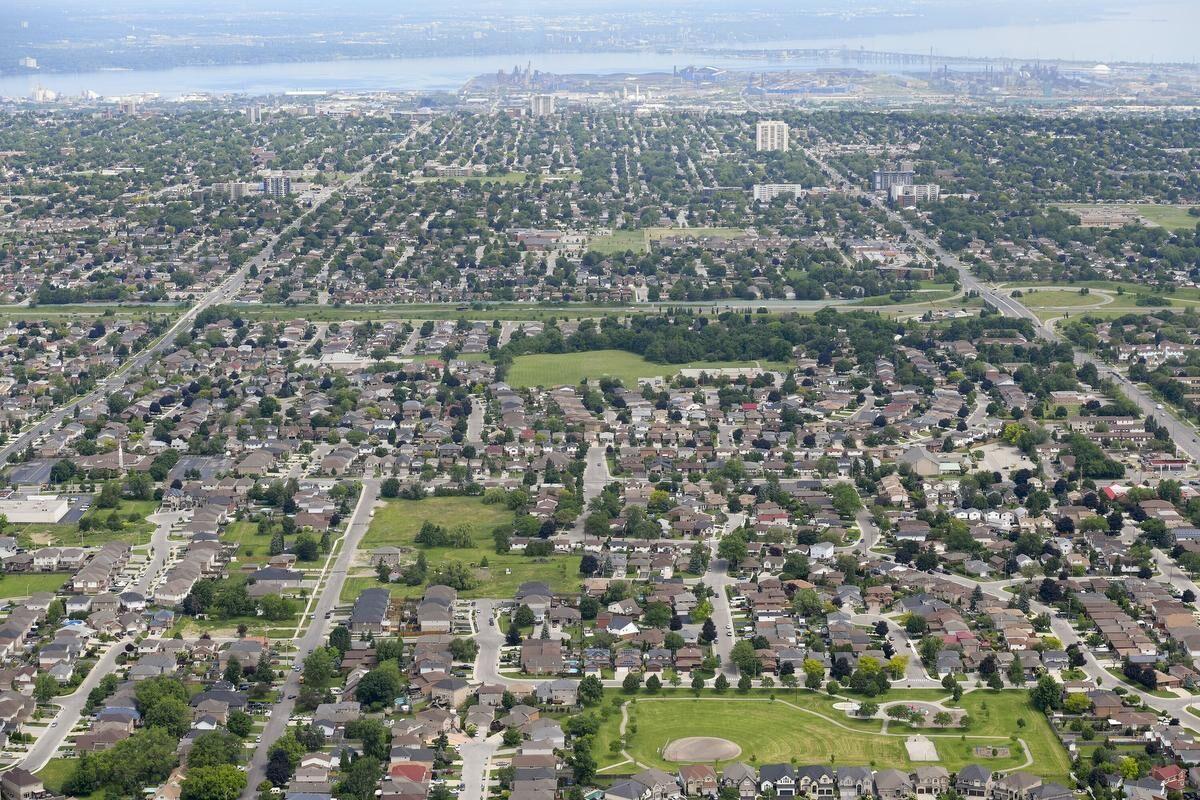Air monitoring shows high levels of cancer-causing pollutant in neighbourhoods across Hamilton
Citywide pollution-tracking found unhealthy levels of common steelmaking pollutant benzo(a)pyrene at monitoring sites from Dundas to Stoney Creek.
By Matthew Van Dongen Spectator Reporter
Saturday, July 8, 2023
The study, funded by Health Canada, measured several air pollutants last year at 60-plus sites using devices attached to utility poles. The air samplers were spread across the lower city — but also on the Mountain and in outlying communities.
Some improvements — like factory pollution controls, but also electrified transportation and cleaner fuels — will have the double-barrelled benefit of cutting greenhouse gas emissions, he added.
One critical example is a “green steel” project by ArcelorMittal Dofasco, which has vowed to end the use of coal by transitioning to electric arc steelmaking furnaces as early as 2028. Both federal and provincial tax dollars are committed to the project, which is expected to dramatically slash both carbon emissions and air pollution.
Stelco has not publicly committed to ending coal use in Hamilton by a particular date, but lease documents suggest its polluting coke-making plant could shut down before 2030.
The province has also recognized the unique local health risk posed by benzene and benzo(a)pyrene by introducing tighter regulations for new industries seeking to set up shop in Hamilton.
Still, local politicians have expressed frustration with provincial air-quality exemptions routinely provided to the city’s big steelmakers that allow them to exceed standards for pollutants like benzo(a)pyrene.
City council voted earlier this year to send a letter opposing further exemptions after learning Dofasco’s latest “site specific standards” for various pollutants were about to expire.
The latest experiment just reinforces those concerns, said Mountain councillor John-Paul Danko. “This (pollution) is obviously a serious issue for people living near industry. But it is also a wider concern.”
Dofasco general manager of environment Gas Gebara said Friday the company is working with the province to develop a “technical standard compliance approach” for the steel industry. He added the planned green steel transition will “eliminate or vastly reduce” problem pollutants like benzene and benzo(a)pyrene.
Gebara also said the overall trend for benzo(a)pyrene emissions from the steelmaker is downward. National Pollutant Release Inventory data shows Dofasco’s annual emissions have dropped by more than half over the last decade.
Matthew Van Dongen is a transportation and environment reporter at The Spectator. mvandongen@thespec.com

Matthew Van Dongen is a Hamilton Spectator reporter. He lives in Hamilton and started working at The Spectator in 2011 after journalism stints in Peterborough and Niagara covering everything from arts to health to the environment. He has been recognized with awards for coverage of hidden pollution threats in Hamilton and historic flooding in Peterborough, among other projects.
Citywide pollution-tracking found unhealthy levels of common steelmaking pollutant benzo(a)pyrene at monitoring sites from Dundas to Stoney Creek.
By Matthew Van Dongen Spectator Reporter
Saturday, July 8, 2023

The study, funded by Health Canada, measured several air pollutants last year at 60-plus sites using devices attached to utility poles. The air samplers were spread across the lower city — but also on the Mountain and in outlying communities.
The Hamilton Spectator file photo
The largest air-monitoring experiment in city history has found unhealthy levels of a cancer-linked contaminant across Hamilton — including in neighbourhoods kilometres away from polluting bayfront industries.
The results suggest coal-fired steelmaking pollutants like benzo(a)pyrene travel far beyond the lower city and pose “an even greater (health) impact than we may have expected,” said Matthew Adams, an urban air-quality expert who is co-ordinating the study alongside city staff.
A promised cut in coal use by Hamilton’s biggest steelmaker should eventually help clear the air — but not before 2028.
In the meantime, Adams said it’s up to governments to do more to regulate and reduce such dangerous pollutants. “It’s not the sort of risk an individual can realistically do much to protect themselves against.”
The study, funded by Health Canada, measured several air pollutants last year at 60-plus sites using devices attached to utility poles. The air samplers were spread across the lower city — but also on the Mountain and in outlying communities like Binbrook, Winona and Freelton — allowing the city to track air quality by neighbourhood and ward.
Results from the study will be shared in a public online meeting Tuesday at 7 p.m. that residents can access via a link from project partner Environment Hamilton’s website by visiting bit.ly/airmeeting.
As expected, levels of pollutants like nitrogen dioxide and sulphur dioxide were generally worse in the lower city near industry or busy roadways, while rural air was cleaner, said Adams, a professor at the University of Toronto.
But nearly all of the 26 air monitors that tested for benzo(a)pyrene recorded summer concentrations above Ontario’s standard for air quality. That included samplers kilometres away from the industrial bayfront in Dundas, on the central and east Mountain, and in Stoney Creek.
The chemical compound, which studies link to cancer, is created by incomplete combustion of organic material. It can come from smouldering wood, cigarette smoke or even burning steak — but the biggest emissions come from coal-fired steelmaking.
Two of the top industrial emitters of benzo(a)pyrene in Ontario are steelmakers in Hamilton: ArcelorMittal Dofasco and Stelco’s bayfront coke plant.
Adams said neighbourhood air testing showed the highest levels near industry. “But what we saw is that most of the city, certainly the urban areas, (were) also above the guideline,” said Adams.
The results appear to ground truth past provincial models that suggest lifetime cancer risk due to benzo(a)pyrene and benzene is higher for Hamilton residents compared to the rest of Ontario.
While pollution levels in the city have dropped significantly since the 1990s, the latest test results show residents must “continue to push” for changes to protect their health, said Environment Hamilton head Ian Borsuk.
The largest air-monitoring experiment in city history has found unhealthy levels of a cancer-linked contaminant across Hamilton — including in neighbourhoods kilometres away from polluting bayfront industries.
The results suggest coal-fired steelmaking pollutants like benzo(a)pyrene travel far beyond the lower city and pose “an even greater (health) impact than we may have expected,” said Matthew Adams, an urban air-quality expert who is co-ordinating the study alongside city staff.
A promised cut in coal use by Hamilton’s biggest steelmaker should eventually help clear the air — but not before 2028.
In the meantime, Adams said it’s up to governments to do more to regulate and reduce such dangerous pollutants. “It’s not the sort of risk an individual can realistically do much to protect themselves against.”
The study, funded by Health Canada, measured several air pollutants last year at 60-plus sites using devices attached to utility poles. The air samplers were spread across the lower city — but also on the Mountain and in outlying communities like Binbrook, Winona and Freelton — allowing the city to track air quality by neighbourhood and ward.
Results from the study will be shared in a public online meeting Tuesday at 7 p.m. that residents can access via a link from project partner Environment Hamilton’s website by visiting bit.ly/airmeeting.
As expected, levels of pollutants like nitrogen dioxide and sulphur dioxide were generally worse in the lower city near industry or busy roadways, while rural air was cleaner, said Adams, a professor at the University of Toronto.
But nearly all of the 26 air monitors that tested for benzo(a)pyrene recorded summer concentrations above Ontario’s standard for air quality. That included samplers kilometres away from the industrial bayfront in Dundas, on the central and east Mountain, and in Stoney Creek.
The chemical compound, which studies link to cancer, is created by incomplete combustion of organic material. It can come from smouldering wood, cigarette smoke or even burning steak — but the biggest emissions come from coal-fired steelmaking.
Two of the top industrial emitters of benzo(a)pyrene in Ontario are steelmakers in Hamilton: ArcelorMittal Dofasco and Stelco’s bayfront coke plant.
Adams said neighbourhood air testing showed the highest levels near industry. “But what we saw is that most of the city, certainly the urban areas, (were) also above the guideline,” said Adams.
The results appear to ground truth past provincial models that suggest lifetime cancer risk due to benzo(a)pyrene and benzene is higher for Hamilton residents compared to the rest of Ontario.
While pollution levels in the city have dropped significantly since the 1990s, the latest test results show residents must “continue to push” for changes to protect their health, said Environment Hamilton head Ian Borsuk.
Some improvements — like factory pollution controls, but also electrified transportation and cleaner fuels — will have the double-barrelled benefit of cutting greenhouse gas emissions, he added.
One critical example is a “green steel” project by ArcelorMittal Dofasco, which has vowed to end the use of coal by transitioning to electric arc steelmaking furnaces as early as 2028. Both federal and provincial tax dollars are committed to the project, which is expected to dramatically slash both carbon emissions and air pollution.
Stelco has not publicly committed to ending coal use in Hamilton by a particular date, but lease documents suggest its polluting coke-making plant could shut down before 2030.
The province has also recognized the unique local health risk posed by benzene and benzo(a)pyrene by introducing tighter regulations for new industries seeking to set up shop in Hamilton.
Still, local politicians have expressed frustration with provincial air-quality exemptions routinely provided to the city’s big steelmakers that allow them to exceed standards for pollutants like benzo(a)pyrene.
City council voted earlier this year to send a letter opposing further exemptions after learning Dofasco’s latest “site specific standards” for various pollutants were about to expire.
The latest experiment just reinforces those concerns, said Mountain councillor John-Paul Danko. “This (pollution) is obviously a serious issue for people living near industry. But it is also a wider concern.”
Dofasco general manager of environment Gas Gebara said Friday the company is working with the province to develop a “technical standard compliance approach” for the steel industry. He added the planned green steel transition will “eliminate or vastly reduce” problem pollutants like benzene and benzo(a)pyrene.
Gebara also said the overall trend for benzo(a)pyrene emissions from the steelmaker is downward. National Pollutant Release Inventory data shows Dofasco’s annual emissions have dropped by more than half over the last decade.
Matthew Van Dongen is a transportation and environment reporter at The Spectator. mvandongen@thespec.com
Matthew Van Dongen is a Hamilton Spectator reporter. He lives in Hamilton and started working at The Spectator in 2011 after journalism stints in Peterborough and Niagara covering everything from arts to health to the environment. He has been recognized with awards for coverage of hidden pollution threats in Hamilton and historic flooding in Peterborough, among other projects.
No comments:
Post a Comment